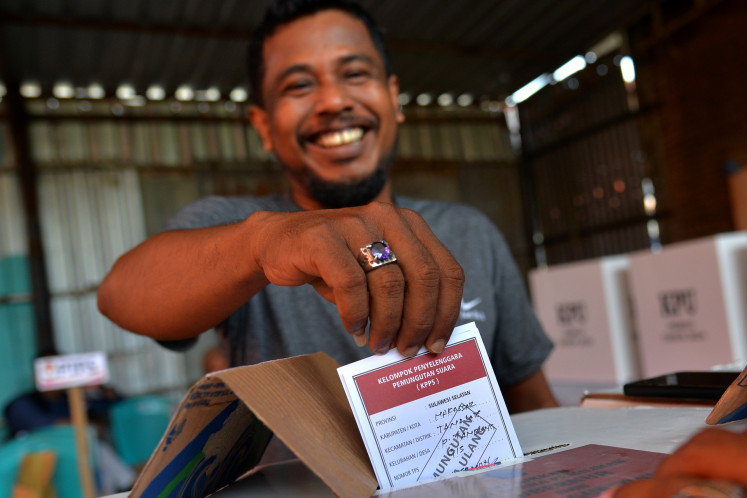Popular Reads
Top Results
Can't find what you're looking for?
View all search resultsPopular Reads
Top Results
Can't find what you're looking for?
View all search resultsSinabung smolders while fear grips evacuees
Mount Sinabung did not unleash a major eruption on Tuesday, but many evacuees were still afraid as experts can not predict future eruptions
Change text size
Gift Premium Articles
to Anyone
M
ount Sinabung did not unleash a major eruption on Tuesday, but many evacuees were still afraid as experts can not predict future eruptions.
Based on reports from a volcano taskforce on Tuesday, Mt. Sinabung still showed a high level of activity, marked by 18 tremors and 18 spurts of volcanic material, some of which were 100 meters high.
“We cannot reduce the alert status yet,” Volcanology and Geological Disaster Mitigation Center (PVMBG) head Surono said.
Brasitepu resident Hartawan Sitepu, 47, said he was still afraid to return home because there had been tremors today and the volcano was still emitting clouds of thick ash.
Another resident, Sitepu, said he, his wife and two children have taken refuge in the Jambur Taras community hall in Brastagi for the past four days. They live five kilometers from the crater.
“We will stay here until it’s safe”.
He said he had been separated from his family before they were reunited at the shelter.
”When the volcano erupted, I was asleep at home. I woke up because I heard a lot of commotion from villagers. I tried to find my family but couldn’t find anyone at home.”
Mount Sinabung, a 2,460-meter -high volcano in Karo regency, was previously classified as a “Type B” volcano, meaning it had been inactive for the last 400 years.
Two people have died since Sunday, when the volcano started to discharge hot lava and volcanic ash.
A more powerful eruption on Monday sent a cloud of volcanic ash billowing 2,000 meters.
The cloud has not disrupted flights from and to Medan’s Polonia International Airport, 27 kilometers from the volcano.
Andang Santosa, an official of airport operator PT Angkasa Pura II, said that there would be no flight delays, adding that Medan-Sibolga flights had been cancelled after flight paths were affected by volcanic ash.
“The route is closed until the weather conditions improve,” he said. He added that he could not predict when flights on the route would resume.
Local authorities did not allow evacuees to return home, despite the lack of a major eruption.
Karo regency secretary Makmur Ginting said that the evacuees, most of who lived within six kilometers from the crater, were still afraid to return home because the volcano was still quite active.
He confirmed that some residents had returned to their homes, but added that they lived more than six kilometers from the volcano.
“More than 6,000 evacuees returned home today, but they live outside a 6-kilometer radius from Sinabung,” said Makmur, adding that around 24,000 people remained in shelters.
Mount Sinabung’s eruption is believed to be its first in four centuries. Some have tried to connect
the re-emergence of Sinabung to Mount Pinatubo in Philippines, which killed more than 800 people in a 1991 eruption after several hundred years of inactivity.
Prihadi Sumintadireja, a professor of volcanology at the Bandung Institute of Technology, said that Pinatubo was morphologically different from Sinabung.
Both are located on the same Eurasian continental plate, which is colliding with the Indo-Australian plate. The Eurasian plate moves between 5 and 12 centimeters annually, resulting in melting magma
that seeks a weak spot to come out, he said.
Sinabung is smaller than Pinatubo, according to Prihadi. The eruption of Sinabung is still categorized as “freatic”, which means that material in its crater is converted into gasses by extreme heat.
The gases push upwards to the surface, causing an eruption.
“It has a beautiful shape, like an inverted V, which theoretically has the potential to erupt,” Prihadi told the Post in Bandung on Tuesday.
PVMBG volcano observer Gede Suantika said that the shape of Pinatubo, which was not sharp, and its surrounding hills showed it has experienced dangerous eruption.
This is different from that of Sinabung, which tends to be perfect, like a cone, Gede said.
The resurgence of volcanic activities at Mt. Sinabung brings the number of Type A volcanoes in Indonesia from 77 to 78.
Indonesia is home to 129 volcanoes, comprising 78 Type A volcanoes, 27 Type B and 24 Type C volcanoes. (rdf)










